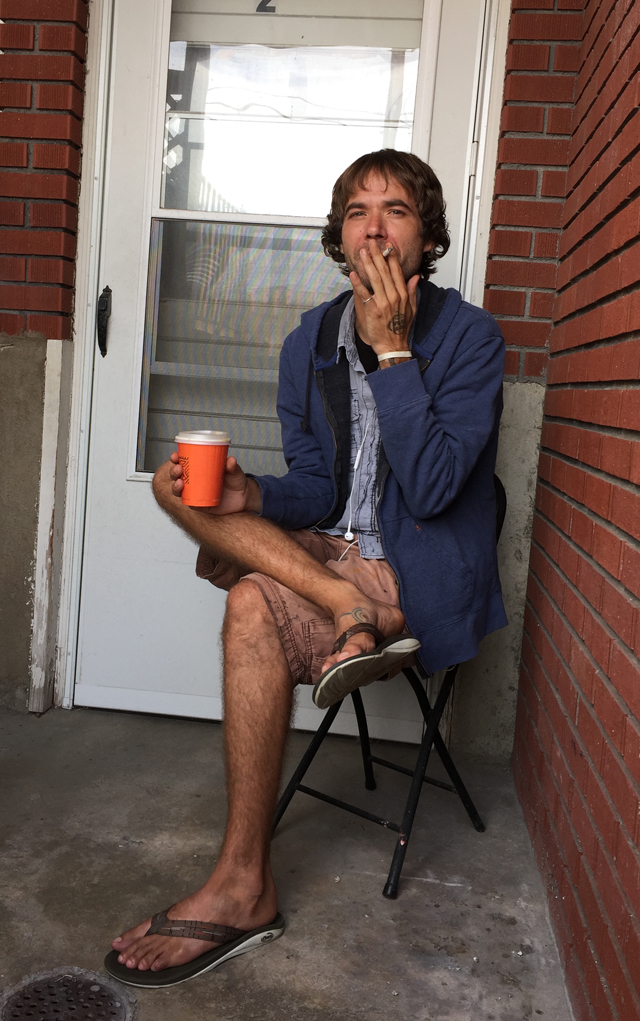
I first met Bradley Books seven years ago through a thin piece of plexiglass. Sitting inside the staff office at the Boulder Shelter for the Homeless, I watched him through the pane as he approached in his wheelchair — a tall, thin and handsome young man who wore a defiant but weary smile on his lips as if to foreshadow all of the greatness that was to come from his pain.
Bradley wasn’t always homeless. He grew up in a nice country family in Osceola, Indiana, playing in farmers’ fields and the Elkhart County railroad yards just like young country boys do. But as he got older his body stopped working like it was supposed to, and soon he found himself spending most of his days in emergency rooms and hospitals.
Over the years, various doctors had different ideas about what ailed Bradley, most of which boiled down to him losing his mind and his body following suit. For years, Bradley was misdiagnosed in “varying degrees of crazy” and spent much of his youth in what he calls “nut huts,” drugged up on powerful antipsychotic medications that tend to knock a man out, or at least down a few notches.
It turns out that Bradley isn’t “crazy” but suffered from exposure to Trichloroethylene (TCE) and Carbon Tetrachloride. In 2008, doctors at Boulder’s Mapleton Center for Rehabilitation realized that the railroad yard he used to play in is now classified as a Superfund site by the Environmental Protection Agency and that the chemicals that he was exposed to there severely affected his development. It wasn’t drugs that Bradley needed, it was help.
Bradley calls those years of being homeless “the deal” — a time when he had to give up everything, including his job, his apartment and his self-understanding in order to accept the help he really needed to get his life back on track.
“Being homeless and in the wheelchair, I lost my independence,” he says. “It was really rough but looking back it was only by breaking down that I became free. Instead of someone else telling me how to live, I found my own free will — I call it the art of living and it is the same process I use to make art.”
Bradley was homeless for 379 days. On the 380th, he moved into housing and acquired a box of paints and some old canvases as a housewarming gift. It was on that day that he created his first painting and became an artist.
Six years later, Bradley has been featured in almost a dozen art shows around Longmont, where he now lives. He currently has a selection of paintings from 2009 on display at the First Lutheran Church. On Sept. 13 his paintings will be available for sale at a fundraiser for Firehouse Art Center and on Sept. 21 he will hold a launch party for the release of his first coloring book, B. Rad Coloring Book 1, at Magic Fairy Candles where it will also be available for sale. It is this wave of recent success that brings me to his basement apartment for a studio tour and interview.

Slits of light barely squeeze through closed blinds to bring a dusty glow to the otherwise dark room. The space is full, almost cluttered, but more like brimming with art stuff — artifacts, books, paints, yarn, mementos of inspiration. And the walls are covered with Bradley’s own paintings from floor to ceiling, with more stacked on the floor.
One of his paintings in progress lies casually on the floor with a gold frame placed loosely on top, adding a touch of refinement and hinting at the impending moment of completion. “Of Course the Purple” is an enchanting painting done in hues of purple acrylic and overlaid with black line drawings of creatures, stick figures and geometric symbols.
“This one is for my grandmother,” Bradley says. “Her last phrase before she passed was, ‘I am finally free from the burdens of life,’ and so this is my release of what I would call my family burden. The painting is of myself taking form, in emotions, thoughts and experiences. I call it the release of the shadow within, whether that is community, religion, politics, really any school of thought or community that says it has to be a certain way. It is a release of those shackles, to become free from those cages and then to operate in non-belief.”
We step outside so that he can smoke a cigarette and drink some coffee, and he tells me that it has been 85 days since he stopped using his cane and four years since he stopped using the wheelchair. In the artistic flurry, I neglected to notice his newfound mobility.
“It was in a moment like this when I decided to stop using my cane,” he says. “I was outside with my cane, coffee and cigarette and the thought in my head was, ‘Which crutch do I want to get rid of?’ And I chose the cane. Now I just have the other two. Isn’t it strange how little thoughts like those are the ones that stop you from feeling breakable and show you that you’re bendable instead? In bending back towards myself. I open up all of my experience into a palette that I then use to make art.”
For Bradley, making art isn’t just about creating, it is about sharing and healing. Two years ago, when he first exhibited paintings at Firehouse Art Center, he was invited by then Executive Director Jessica Kooiman Parker to speak to a group from Imagine!, a program for adults with mental disabilities, who were coming in to tour the exhibition.
“I talked to them about my process,” he says. “I usually pick up the colors prior to the painting which are related to the emotions that spring out. I do layers upon layers. Sometimes a painting will be painted just to express something that I needed to, and then I will do a painting on top of that painting to balance it all out. Maybe the rage is what brought me to paint, but it is not what I want to express so I use it as the backbone of the painting and then paint a lightness on top. But if you follow the brush strokes, it can pull you back down to what is underneath, or take you back out, I guess.”
The tour was so successful that it spawned Art of Possibilities, a program inspired by Book’s own experience with art as therapy and for which he serves as co-facilitator and mentor. The program brings groups of 25 adults with disabilities from Imagine! into the art center to tour each exhibition, discuss the art and then create their own pieces. After two years, the program is going strong and growing.

“I actually bought a piece of his work, ‘NoBo Hobo,’ from that first January show,” Kooiman Parker says. “He can really paint emotions and tell a story that has a different effect on you than other paintings. For me what is so striking is the vulnerability that is there on the canvas. You can feel a lot of different things just by looking at it, you can be sad and happy at the same time, tapping into this other world that not a lot of people can see, or even if they can they can’t express. It is an innocent perspective yet it is dark.”
Bradley calls this the high lonesome, drawing on the bluegrass and folk musical traditions that he loves so much.
“I don’t think of myself as happy or unhappy, those emotions seems sort of trite and unimportant — it is bubble gum and hot air for me,” he says. “Life is a relentless succession of moments and I operate in sort of general anxiety, almost like it comforts me. And then I piece all the experience and all the anxiety together in someway and turn it into a poem or a painting or a drawing.”
He pauses for a moment and exhales a plume of cigarette smoke. “But my favorite is the clouds,” he says. “The birds in flight and their shadows. Art is just what there is.”
On the Bill: Extinguish Your Thirst — Fundraiser for Firehouse Art Center. 6:30 p.m. Tuesdays, Sept. 13, Wibby Brewing, 209 Emery St., Longmont, 303-776-4595.














